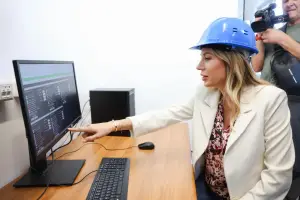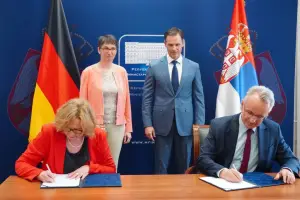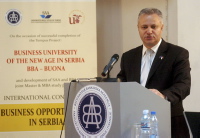- Serbia
Get to know Serbia
- Citizens
Culture and science
Health services
Pension and disability insurance
- Business
Employment
Economy
- Media
- Government
- Contact
Keep in touch
Contact form
Back
Keepin touch
Whether you have a question, comment, suggestion or any problem in the purview of the government, send us your message and we will try to respond as soon as possible. If your problem is not in our purview, we will forward your message to the relevant institution.
Q:
A:
No salary, pension cuts or VAT increases
Belgrade,
22 June 2009
Deputy Prime Minister and Minister of Economy and Regional Development Mladjan Dinkic today stated that the state will not cut salaries and pensions, or increase VAT, but will increase the budget deficit and reduce public administration in order to compensate for budget revenues.
Opening the international conference on business opportunities in Serbia, themed "Examples from Italian Business and the Role of Education in Management", held at the Faculty of Banking, Insurance and Finance in Belgrade, Dinkic stressed that salary and pension cuts in this time of crisis would additionally decrease demand, while a VAT increase would imply ‘pumping out’ liquidity from the economy.
He said Serbia will increase their budget deficit, that is, increase its indebtedness and reduce public administration, which means it will not lower salaries but the number of employees.
He stressed that Serbia has much less debt than other European countries, noting that the average debt in the EU is 100% of GDP, while budget deficit averages 6% of GDP, which is twice Serbia’s.
The Deputy Prime Minister said that the crisis reached its peak near the end of the first quarter, adding that since then the economy has become more stable at lower levels, stressing that it will take some time for it to recover from the crisis, most likely after the fourth quarter of 2009.
He explained that the effects of the crisis will be bankruptcy for some companies in the real sector, mostly in developed countries, which is why production will be transferred to countries with lower production costs.
Here I see an opportunity for Serbia in the years to come, which is why this year we must cut red tape and maintain a stimulating tax system, Dinkic said, adding that the ‘cure for the crisis’ is more loans from banks to increase demand and liberate consumers and investors from an unrealistic fear.
Dinkic said that Serbia will come out of the crisis ‘without much harm’, adding that a portion of Western Europe industry will be moved to Serbia in the next few years.
He stated that $1 in investment generates $3 of economic growth and noted that Italian companies have so far invested €800 million, making Italy one of the top five investors in Serbia.
Italian banks Banca Intesa, UniCredit and Findomestic make up 25% of the Serbian banking sector, Dinkic said.
Dinkic added that Fiat has increased car production in the Kragujevac Zastava car factory from 40 to 120 cars per day and should increase its output to 200 cars per day by September this year.
Zastava has produced 20,000 cars this year, compared with 9,800 produced in 2008, he said, adding that a new model should come out of Kragujevac in 2011.
He said Serbia will increase their budget deficit, that is, increase its indebtedness and reduce public administration, which means it will not lower salaries but the number of employees.
He stressed that Serbia has much less debt than other European countries, noting that the average debt in the EU is 100% of GDP, while budget deficit averages 6% of GDP, which is twice Serbia’s.
The Deputy Prime Minister said that the crisis reached its peak near the end of the first quarter, adding that since then the economy has become more stable at lower levels, stressing that it will take some time for it to recover from the crisis, most likely after the fourth quarter of 2009.
He explained that the effects of the crisis will be bankruptcy for some companies in the real sector, mostly in developed countries, which is why production will be transferred to countries with lower production costs.
Here I see an opportunity for Serbia in the years to come, which is why this year we must cut red tape and maintain a stimulating tax system, Dinkic said, adding that the ‘cure for the crisis’ is more loans from banks to increase demand and liberate consumers and investors from an unrealistic fear.
Dinkic said that Serbia will come out of the crisis ‘without much harm’, adding that a portion of Western Europe industry will be moved to Serbia in the next few years.
He stated that $1 in investment generates $3 of economic growth and noted that Italian companies have so far invested €800 million, making Italy one of the top five investors in Serbia.
Italian banks Banca Intesa, UniCredit and Findomestic make up 25% of the Serbian banking sector, Dinkic said.
Dinkic added that Fiat has increased car production in the Kragujevac Zastava car factory from 40 to 120 cars per day and should increase its output to 200 cars per day by September this year.
Zastava has produced 20,000 cars this year, compared with 9,800 produced in 2008, he said, adding that a new model should come out of Kragujevac in 2011.
-
 Belgrade, 11 August 2025
Belgrade, 11 August 2025Support for agricultural projects worth RSD 750 million
-
 Belgrade, 21 July 2025
Belgrade, 21 July 2025Construction of oil pipeline with Hungary to begin early next year
-
 Belgrade/Athens, 17 July 2025
Belgrade/Athens, 17 July 2025Serbia continues to align with EU in field of energy
-
 Kostolac, 14 July 2025
Kostolac, 14 July 2025First solar power plant Petka in Kostolac put into trial operation
-
 Belgrade, 11 July 2025
Belgrade, 11 July 2025Potential for improving cooperation with Belarus in many areas
-
 Požega, 5 July 2025
Požega, 5 July 2025Section of Pakovraće - Požega highway officially opened
-
 Belgrade, 2 July 2025
Belgrade, 2 July 2025Technical specifications defined for Serbia-Hungary oil pipeline
-
 Belgrade, 30 June 2025
Belgrade, 30 June 2025IMF confirms Serbia successfully implementing all agreed reforms
-
 Belgrade, 27 June 2025
Belgrade, 27 June 2025Double Taxation Avoidance Agreement with Germany signed
-
 Kostolac, 25 June 2025
Kostolac, 25 June 2025Construction of Kostolac wind farm nearing completion

